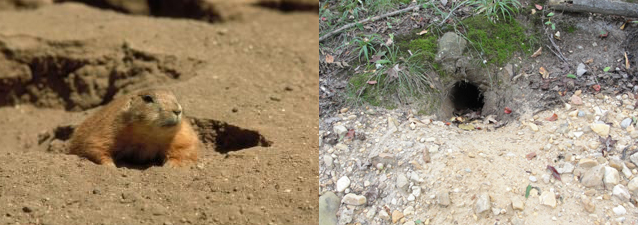Emergencies, like a blocked exit, can develop quickly and unexpectedly, and this doesn't leave time to plan an escape. Planning before an emergency strikes greatly increases everyone's chances of escaping safely.

NPS Structural Fire Chief: Good morning, Phil, and thank you for talking with me. If you could, please tell our readers why groundhogs are considered among the best at planning for escape from emergencies.
Punxsutawney Phil: Yes, of course. We groundhogs spend most of our time in underground burrows. These burrows, like many homes, have one main entrance, but also have up to four auxiliary entrances. This allows groundhogs many options to enter and exit their homes in case the main entrance is blocked.

Hal: Great planning! Now, in preparation for the long winter indoors, what do you do to ensure your family will be safe in case of an emergency?
Phil: Emergencies, like a blocked exit, can develop quickly and unexpectedly, and this doesn't leave time to plan an escape. Planning before an emergency strikes greatly increases everyone's chances of escaping safely. I follow these three simple steps:
- Have a Plan.
- Know the Plan.
- Practice the Plan.
Hal: I realize that groundhogs don't have windows in their burrows, but what if you did? How can you use windows in an escape?
Phil: If you plan to use windows as emergency exits in your home, practice using them. Be sure that all the windows open easily and that you can safely get to the ground. Don't forget a plan for opening those screens and security bars. They need to open from the inside without special tools or specialized knowledge.
Hal: That is some very sound advice, Phil. Do you have any other helpful hints for our readers?
Phil: Now it will depend on if I see my shadow or not on Groundhog Day, but if we are going to have six more weeks of winter, be aware that according to the National Fire Protection Association (NFPA), house fires are more frequent in winter than in any other season.
Phil: Be safe everyone, and look for me on Groundhog Day!!
Disclaimer: This was not a real interview.
Fire Info for You
Employees
- Do you have children, persons with disabilities, and/or seniors living in your home? It is especially important to have an escape plan and to have practiced it.
- Do your kids attend sleepovers? Have a home fire escape plan and share it with any sleepover guests.
Park Leadership
- OSHA requires a written emergency evacuation plan in workplaces with more than 10 employees. Ensure that current emergency evacuation plans are written, known, and rehearsed by all employees within NPS-owned and -managed buildings. Read the required elements of a plan.
- Contact your park's structural fire coordinator or regional structural fire manager for additional guidance.
Regional/National Leadership
OSHA 29 CFR 1910.38 requires emergency evacuation plans in workplaces with more than 10 employees. Assist park managers in becoming compliant with this OSHA regulation by making the necessary tools and resources available.
Take Action
- Find out if your office has a fire escape plan. Can you locate the two closest doors that lead outside? Does the plan tell you where to meet?
- If your office does not have a fire escape plan, ask your supervisor why not.
- Take it home: Make a fire escape plan for your home.
NPS Fire Facts
Read about the site of the first large-scale strike of women workers in the country and one of the worst industrial fire disasters in American history. This event led to dramatically improved fire and safety features required in buildings today. This location is now a National Historic Landmark.
Last updated: February 2, 2021
